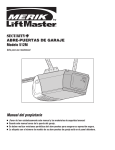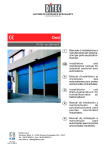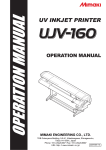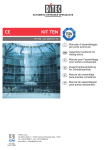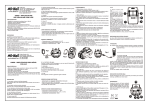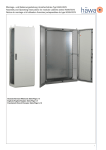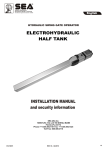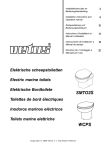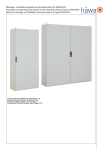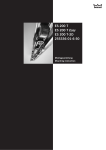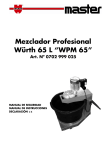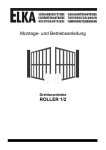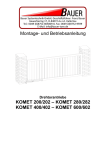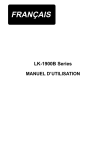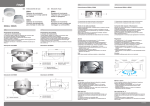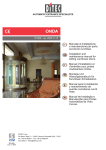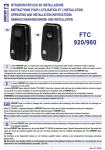Download AST-ASME-ASMI
Transcript
AST-ASME-ASMI IP1628 - rev. 2008-06-03 I GB F D E P DITEC S.p.A. Via Mons. Banfi, 3 - 21042 Caronno Pertusella (VA) - ITALY Tel. +39 02 963911 - Fax +39 02 9650314 www.ditec.it - [email protected] Manuale di installazione per dispositivi a sfondamento. Installation manual for break-out devices. Manuel d’installation pour dispositives de défocement. Wartungshandbuch für Durchbohrungsvorrichtung. Manual para la instalaciòn para dispositivos de desfonde. Manual de instalação para dispositivos de abertura. AST Sistema di sfondamento ante mobili e fisse / Panic system for mobile and fixed wings / Système d’enfoncement vantaux mobiles et fixes / Break-Out-System für Fahrflügel und Seitenteile / Sistema de desfonde hojas móviles y fijas / Sistema de abertura de folhas móveis e fixas min. 2000 10.5 Fotocellula Photocell Photocelle Lichtschranke Fotocélulas Fotocélulas Fig. 1 Fig. 2 ASME Sistema di sfondamento sole ante mobili / Panic system for mobile wings only / Système d’enfoncement vantaux mobiles seulement / Break-Out-System nur für Fahrflügel / Sistema de desfonde, sólo hojas móviles / Sistema de abertura somente para folhas móveis min. 2000 8÷10 Fig. 3 AST-ASME-ASMI - IP1628 Fotocellula + KASME Photocell + KASME Photocelle + KASME Lichtschranke + KASME Fotocélulas + KASME Fotocélulas + KASME Fig. 4 2 ASMI Sistema di sfondamento sole ante mobili / Panic system for mobile wings only / Système d’enfoncement vantaux mobiles seulement / Break-Out-System nur für Fahrflügel / Sistema de desfonde sólo hojas móviles / Sistema de abertura somente para folhas móveis min. 2000 10.5 Fotocellula Photocell Photocelle Lichtschranke Fotocélulas Fotocélulas Fig. 5 Fig. 6 Attenzione: il sistema ASMI è sfondabile solo con ante completamente chiuse. Warning: the ASMI system can be broken through only when wings are fully closed. Attention: le système ASMI ne peut être enfoncé que si les vantaux sont complètement fermés. Achtung: das ASMI System kann nur aufgeschwenkt werden, wenn die Türflügel vollständig geschlossen sind. Atenciòn: el Sistema ASMI es desfondable únicamente si las hojas están completamente cerradas. Atenção: o sistema ASMI pode ser aberto somente se as folhas estiverem completamente fechadas. Larghezza anta Wing width (mm) min. 650 700 800 900 1000 1100 1200 (*) 1300 (*) 1400 (*) Peso massimo singola anta Single wing maximum weight (Kg) TEN 100 100 100 80 70 60 / / / REX 100 100 100 80 70 60 / / / BISO-V 120 120 120 110 110 100 100 90 80 Attenzione: i sistemi di sfondamento AST, ASME e ASMI sono omologati TÜV in abbinamento ad automazioni DITEC modelli BIS-O, BIS-V e TEN, e presso il Ministero dell’Interno della Repubblica Italiana in abbinamento ad automazione REX. Le ante utilizzate sono da intendersi costruite con profili DITEC serie PAM35-PAM35F. L’altezza massima delle ante mobili sfondabili (HM) non deve superare 2400 mm. Quando il peso dell’anta fissa è superiore a 100 kg, aggiungere una terza cerniera (vedere KCER2). (*) Aggiungere il terzo carrello sull’anta. Attention: AST, ASME and ASMI panic devices are TUV approved coupled with DITEC automation models BIS-O, BIS-V and TEN, and approved coupled with REX automation by the Minister of Interior of the Italian Republic. The wings utilised are to be constructed with DITEC PAM35-PAM35Fprofiles. The break-out mobile wings (HM) should not exceed 2400 mm in height. Add a third hinge (see KCER2) when the weight of the fixed wing exceeds 100 kg. (*) Add a third carriage on the wing. Attention: les systèmes de défoncement AST, ASME et ASMI sont homologués TÜV en couplage avec les automations DITEC modèles BIS-O, BIS-V et TEN, et auprès du Ministère de l’intérieur de la République Italienne en couplage avec l’automation REX. Les portes utilisées sont construites avec des profils DITEC série PAM35PAM35F. La hauteur maximum des portes mobiles qui peuvent être défoncées (HM) ne doit pas dépasser 2400 mm. Quand le poids de la porte fixe est supérieur à 100 kg, ajouter une troisième charnière (voir KCER2). (*) Ajouter le troisième chariot sur la porte. Achtung: die Break-Out-Systeme AST, ASME und ASMI sind in Verbindung mit den DITEC-Automationsmodellen BIS-O, BIS-V und TEN, und beim Innenministerium der italienischen Republik in Verbindung mit der REX-Automation, TÜV geprüft. Die verwendeten Flügel werden mit DITEC-Profilen der Serie PAM35-PAM35F hergestellt. Die Höhe der Fahrflügel mit Break-Out-System (HM) darf 2400 mm nicht überschreiten. Liegt das Gewicht des festen Flügels über 100 kg, muss ein drittes Scharnier hinzugefügt werden (siehe KCER2). (*) Den dritten Fahrflügel hinzufügen. Atención: los sistemas antipánico de hojas abatibles por simple empuje manual AST, ASME y ASMI poseen la homologación TÜV si están instalados en combinación con automatizaciones DITEC de los modelos BIS-O, BIS-V y TEN, y poseen también la homologación Ministerio del Interior de la República Italiana en combinación con la automatización REX. Se entiende que las hojas utilizadas están construidas con perfiles DITEC serie PAM35-PAM35F. La altura máxima de las hojas móviles abatibles por simple empuje manual (HM) no debe ser superior a 2400 mm. Si el peso de la hoja fija supera los 100 kg, será necesario añadir una tercera bisagra (ver KCER2). (*) Añadir una tercera corredera a la hoja. Atenção: os sistemas antipânico AST, ASME e ASMI são homologados TÜV adequados a automações DITEC modelos BIS-O, BIS-V e TEN, e no Ministério do Interior da República Italiana adequado a automação REX. As portas utilizadas devem ser construídas com perfis DITEC série PAM35-PAM35F. A altura máxima das portas móveis de correr (HM) não deve superar os 2400 mm. Quando o peso da porta fixa for superior a 100 kg, adicionar uma terceira dobradiça (ver KCER2). (*) Adicionar o terceiro carrinho à porta de correr 3 AST-ASME-ASMI - IP1628 ASME Preparazione anta mobile con profili commerciali / Mobile wing setting up with commercial frames / Préparation du vantail mobile avec profilés commerciaux / Vorbereitung des Fahrflügel mit handelsüblichen Profilen / Preparación hoja móvil con perfiles comerciales / Preparação da folha móvel com perfis comerciais Ø13 100 20 130 75 20 50 OPEN min 40 HM OPEN 100 8÷10 12 45 20 37 AST-ASME-ASMI - IP1628 Fig. 7 4 ASMI Preparazione anta mobile con profili commerciali / Mobile wing setting up with commercial frames / Préparation du vantail mobile avec profilés commerciaux / Vorbereitung des Fahrflügel mit handelsüblichen Profilen / Preparación hoja móvil con perfiles comerciales / Preparação da folha móvel com perfis comerciais 20 Ø13 130 20 50 100 10.5 HM 100 OPEN 12 Y OPEN 45 20 32 Fig. 8 HM Y LM Fig. 9 5 AST-ASME-ASMI - IP1628 21 1 11 12 10 5 20 7 + - 19 13 17 2 9 3 18 8 4 31 16 6 14 15 14 AST-ASME-ASMI - IP1628 Fig. 10 6 SP 4 20 30 71 ~20 100 24 ~200 300 100 40 20 6MA 3 8 LM 17 45 9 25 30 SP 18 6 4 Fig. 11 Fig. 12 2 21 11 LM-1 1 LM-5 10 12 1 5 20 8 2 13 4 LM LM fig. 13 fig. 14 7 AST-ASME-ASMI - IP1628 Kit cerniere / Hinges / Kit charnières / Scharniere / Bisagras / Kit de dobradiças 179 23 Ø9.3 Ø9.3 Ø9.3 Ø9.3 23 Ø9.3 A Ø9.3 23 23 Ø9.3 Ø9.3 23 Ø9.3 M6 118 M6 130 163 A Ø9.3 LEFT MOUNTING A Ø9.3 - Forare i profili e assemblare le cerniere come da figura. - Drill the profiles and assemble the hinges as show in figure. - Percer les profilés et assembler les charnières comme indiqué en figure. - Nehmen Sie die Bohrungen in den Profilen vor und setzen Sie die Scharniere wie abgebildet zusammen. - Taladrar los perfiles y ensamblar las bisagras como en la figura. - Perfurar os perfis e montar as dobradiças como indicado na figura. RIGHT MOUNTING - Utilizzare gli inserti [A] nel caso di ante apribili verso l’esterno. - Use the insert [A] for doors that open externally. - Utiliser les elements [A] dans le cas de portes ouvrant vers l’exterieur. - Bei Flugel zum Öffnen nach außen die Befestigung [A] verwenden. - Utilizar los insertos [A] en caso de hojas que se abran hacia el externo. - Utilize as inserções [A] no caso de folhas que se abrem para fora. - Inserire le boccole con la freccia rivolta verso l’anta fissa sfondabile (posizione 0). Per avvicinare l’anta al telaio agire sulla boccola superiore; per allontanare l’anta al telaio agire sulla boccola inferiore. Portata: 2 cerniere 100 kg. - Insert the bushes with the arrow turned towards the fixed breakable down wing (position 0). Operate the upper bush to move the wing closer to the frame; operate the lower bush to move the wing away from the frame. Load: 2 hinges 100 kg. 1 mm 0 0 1 mm - Introduire les douilles en orientant la fléche vers l’ouvrant (position 0). Agir sur la douille superieure pour approcher l’ouvrant du dormant; Agir sur la douille inferieure pour eloigner l’ouvrant du dormant. Portée: 2 charniéres 100 kg. - Buchsen einsetzen, wobei der Pfeil zu dem ausschwenkbaren Seitenteil zeigen muss (Position 0). An der oberen Buchse stellen um den Abstand zwischen Flügel und Rahmen zu verkleinern, an der unteren Buchse stellen um ihn zu vergrößern. Tragfähigkeit: 2 Scharniere 100 kg. - Introducir los casquillos con la flecha en direcciòn de la hoja mòvil (posiciòn 0). Para acercar la hoja el marco actuar sobra el casquillo superior; para alejar la hoja del marco actuar sobra el casquillo inferior. Peso: 2 bisagras 100 kg. - Introduza os casquilhos com a seta virada na direcção da folha fixa a abrir (posição 0). Para aproximar a folha a estrutura, agir no casquilho superior; para afastar a folha da estrutura, agir no casquilho inferior. Capacidade: 2 dobradiças 100 kg. AST-ASME-ASMI - IP1628 8 KSERS1-2-3-4-5 Kit serratura a spillo / Pin lock kit / Kit serrure à broche / Bausatz Stangenschloß / Equipo cerradura de aguja / Kit fechadura a agulha LM 10.5 = = 112 HM-251 15 77 Ø3 1x45° Ø18 Ø8 15 33 70 213 147.5 Ø3 200 16 119 max 7.5 3 32.5 34 M6 HM-251 1x1.5 7 45 Ø6.5 fig. 15 Schema dei collegamenti su sfondamento AST / Wiring diagram for the AST panic device / Schéma des connexions sur dispositif d’enfoncement AST / Anschlußschema für AST-System / Esquema de las conexiones del dispositivo de desfonde AST / Esquema das ligações na abertura AST 1 0 Brown Black Blue Brown Blue ASM ASM OPEN AST Black Brown Blue Magnetic switch CONTROL PANEL 9 OPEN TX RX SICUR2 Magnetic switch Black Brown Blue AST SICUR2 fig. 16 9 AST-ASME-ASMI - IP1628 Schema dei collegamenti su sfondamento ASME / Wiring diagram for the ASME panic device / Schéma des connexions sur dispositif d’enfoncement ASME / Anschlußschema für ASME-System / Esquema de las conexiones del dispositivo de desfonde ASME / Esquema das ligações na abertura ASME 1 0 Brown Black Blue Brown Blue ASM KASME Black OPEN ASM OPEN TX 9 CONTROL PANEL STOP KASME RX Grey fig. 17 Schema dei collegamenti su sfondamento ASMI / Wiring diagram for the ASMI panic device / Schéma des connexions sur dispositif d’enfoncement ASMI / Anschlußschema für ASMI-System / Esquema de las conexiones del dispositivo de desfonde ASMI / Esquema das ligações na abertura ASMI Brown Black Blue Brown Blue ASM Black OPEN 9 1 0 CONTROL PANEL STOP ASM OPEN TX RX Grey fig. 18 TX Brown Blue 9 1 0 CONTROL PANEL STOP 9 Brown Black Blue COMH-K Schema dei collegamenti con selettore di funzioni COMH-K / Wiring diagram with COMH-K function selector / Schéma des connexions avec sélecteur de fonctions COMH-K / Anschlußschema mit Funktionswählschalter COMH-K / Esquema de las conexiones con selector de funciones COMH-K / Esquema das ligações com selector de funções COMH-K RX fig. 19 AST-ASME-ASMI - IP1628 10 1. Kit necessari per costruzione serramenti con dispositivi AST-ASME-ASMI Profili commerciali PAM35-PAM35F APPLICAZIONE [*] Kit serratura opzionale AST Sfondamento di una anta mobile e una anta fissa con profili PAM35 AST Sfondamento di due ante mobili e due ante fisse con profili PAM35 ASME Sfondamento di una anta mobile con profili PAM35 ASME Sfondamento di due ante mobili con profili PAM35 ASMI Sfondamento di una anta mobile con profili PAM35 ASMI Sfondamento di due ante mobili con profili PAM35 ASME Sfondamento di una anta mobile con profili commerciali ASME Sfondamento di due ante mobili con profili commerciali ASMI Sfondamento di una anta mobile con profili commerciali ASMI Sfondamento di due ante mobili con profili commerciali KASM1 KASM2 1 - - 1 1 1 I KASME KSERS* 1 - 1 - 2 - 2 - 1 - 1 1 1 1 2 - 1 2 1 - 1 - - 1 1 1 2 - - 2 1 - - - 1 1 1 1 - - 1 2 1 - - - - 1 1 1 - - - 2 5. Attenzione: nel caso di verniciatura, i profili devono essere chiusi per evitare che lo spessore della vernice provochi un cattivo funzionamento. Non verniciare la guida a pavimento in alluminio. Collegamenti elettrici sistema AST-ASME-ASMI - Forare il montante verticale del serramento fisso sul lato del vano passaggio e montare la fotocellula SICUR2 come indicato in fig. 2-4-6. - Effettuare i collegamenti elettrici come indicato in fig. 16-17-18. Se viene utilizzato il selettore di funzioni COMH-K, collegare il cavo marrone del ricevitore al morsetto 9 del selettore (fig. 19). - Eventuali altri dispositivi devono essere collegati in serie al collegamento 1-9 (STOP). 2. Preparazione anta e montaggio sistema sfondamento anta mobile ASME-ASMI - (Fig. 11) Predisporre un rinforzo in ferro nel traverso superiore dell’anta. - (Fig. 11) Forare l’anta 30x30 mm e 6MA. In base ai profili utilizzati, se necessario, inserire all’interno del montante verticale due spessori SP per mantenere verticali e paralleli al montante i perni [4] e [6]. - (Fig. 11) Montare il perno inferiore [6] nel foro inferiore dell’anta e fissarlo con le viti [16]. - (Fig. 13-15) In base al senso di sfondamento e alla lunghezza LM dell’anta, tagliare a misura i profili [1] e [2]. - (Fig. 12) Passare il perno [4] nel foro del piatto [3] e bloccare l’accoppiamento con la spina [17] inserita fino al dritto del piatto [3]; posizionare in sede la spina [8] e montare la testata [9] con la vite [18] sul piatto [3]. - (Fig. 13) Infilare il perno [4] così assemblato nel profilo [2] e fissare il tutto all’anta con le viti [31] e [19] in dotazione. Attenzione al senso di sfondamento. Prevedere almeno un ulteriore punto di fissaggio del profilo [2] all’anta. - (Fig. 13) Assemblare lo scrocco [7] e passarlo nel profilo [2]; (Fig. 10) la forza di sfondamento dell’anta si regola spostando lo scrocco [7] lungo il profilo [2] e comprimendo la molla agendo sull’apposita vite ad esagono incassato da 4 mm. - (Fig. 14) Passare il profilo [1] nel braccio [5] e fissarlo con le viti a testa svasata [20] in dotazione. - (Fig. 14) Infilare l’insieme così montato nel perno [4], montare la calotta di copertura [10], passare la rondella forata [11] nella spina [8] incastrandola anche sulla calotta [10], chiudere i profili e bloccare il tutto con la vite [21]; montare le testatina di plastica [12] e [13] sui profili [1] e [2]. - (Fig. 8-9) Nel caso di utilizzo del sistema ASMI, predisporre un tubolare [Y] da avvitare al montante verticale dell’anta. 3. KIT NECESSARI KASM1A KAST1A 6. Fotocellula SICUR2 Quando il ricevitore (RX) ed il trasmettitore (TX) della fotocelllula SICUR2 sono alimenatati e correttamenete allineati, il led verde presente sul ricevitore RX è acceso. TX RX LED Black 7. Grey Verifica del funzionamento - Al termine dell’installazione verificare che la forza necessaria per sfondare ogni singola anta non superi 220 N. La misura si effettua a 1 m dal pavimento in corrispondenza del bordo di chiusura (opposto alle cerniere). E’ possibile regolare la forza come indicato al paragrafo 2 e in fig. 10. - Verificare che, quando le ante (mobili e fisse) sono sfondate, il movimento automatico della porta cessi. La fotocellula SICUR2 serve per rilevare lo sfondamento delle ante mobili, il microinterruttore magnetico serve per rilevare lo sfondamento delle ante fisse. Fissaggio guide a pavimento - Posizionare la guida [15] per tutta la lunghezza della corsa in apertura dell’anta mobile. Fissare a pavimento la guida [15] e le testatine [14] in più punti. 4. Kit serrature (fig. 15) E’ possibile installare sul profilo la serratura a chiave per il bloccaggio del serramento completo (funzione notte). Attenzione: per garantire la sicurezza di funzionamento, deve essere installata l’asta blocco anta inferiore (non di nostra fornitura) come indicato nel particolare di fig. 15. 11 AST-ASME-ASMI - IP1628 Commercial profiles PAM35-PAM35F GB 1. Kits required for building door frames with AST-ASME-ASMI devices APPLICATION [*] Optional lock kit AST Panic device for one mobile and one fixed wing with PAM35 profiles AST Panic device for two mobile and two fixed wings with PAM35 profiles ASME Panic device for a single mobile wing with PAM35 profiles ASME Panic device for two mobile wings with PAM35 profiles ASMI Panic device for a single mobile wing with PAM35 profiles ASMI Panic device for two mobile wings with PAM35 profiles ASME Panic device for a single mobile wing with commercial profiles ASME Panic device for two mobile wings with commercial profiles ASMI Panic device for a single mobile wing with commercial profiles ASMI Panic device for two mobile wings with commercial profiles KASM2 KASME KSERS* 1 - - 1 - 1 1 1 - 2 - 2 1 - 1 - 1 1 1 1 2 - 1 2 1 - 1 - - 1 1 1 2 - - 2 1 - - - 1 1 1 1 - - 1 2 1 - - - - 1 1 1 - - - 2 5. Attention: in case of painting, the sections must be closed so as to prevent paint layer from causing any system malfunction. Do not paint the aluminium guide on the floor. - (Fig. 11) Mount an iron reinforcing bar in the top cross member of the wing - (Fig. 11) Drill a hole of 30x30 mm and 6MA. Depending on the type of sections employed, insert two SP shims inside the jamb to keep the pins [4] and [6] vertical and parallel to the jamb, if required. - (Fig. 11) Fit the lower pin [6] into the lower hole of the wing and secure by means of the screws [16]. - (Fig. 13-15) Cut sections [1] and [2] to size according to the breakthrough direction and the length, LM, of the wing. - (Fig. 12) Insert the pin [4] in the hole of plate [3] and secure the coupling by means of dowel [17], straight away of the plate [3] inserted; place the dowel [8] in its seat and attach the headpiece [9] to plate [3] by means of screw [18]. - (Fig. 13) Insert the pin [4] thus mounted into section [2] and secure to the wing by means of the screws [31] and [19] provided. Pay utmost attention to break-through direction. Provide for at least a further anchoring point for section [2] to the wing. - (Fig. 13) Assemble the latch [7] and fit it into section [2]; (fig. 10) the force required to break through the wing can be adjusted by moving the latch [7] along section [2] and compressing the spring by means of the appropriate 4mm socket hexagonal-head screw. - (Fig. 14) Insert section [1] into arm [5] and secure by means of the flathead screws [20] provided. - (Fig. 14) Insert the parts thus assembled into pin [4] and fit on the cover [10]. Insert the perforated washer [11] into dowel [8] also fitting it into cover [10], close the profile and secure by means of screw [21]. Finally, fit plastic headpiece [13] on to sections [1] and [2]. - (Fig. 8-9) In case of the ASMI system being used, screw a piece of tubing [Y] to the wing jamb. 6. TX RX LED Black 7. Grey Checking operations - Upon completion of installation check that the force required to open each wing is no more than 220 N. This measurement is taken 1 m from the floor at the closing door edge (opposite the hinges). For force adjustment, see paragraph 2 and fig. 10. - Check that automatic door movement stops upon the mobile and fixed wings having been broken through. Mobile wing breakthrough is detected by the SICUR2 photoelectric cell, while fixed wing break-through is detected by a magnetic microswitch. Securing guideways to floor Lock kit (fig. 15) Key lock may be fitted to the section for completely locking the door (night function). Attention: for maximum operating safety it is necessary that the lower wing lock rod (not supplied by us) be installed as outlined in the detail of fig. 15. AST-ASME-ASMI - IP1628 SICUR2 photocell When the receiver (RX) and the transmitter (TX) of the photocell SICUR2 are powered and correctly aligned, the green LED on the receiver RX will light up. - Position the guide [15] along the entire length of the moving wing’s opening travel. Anchor the guide [15] and the heads [14] to the floor in various points. 4. Electrical connections AST-ASME-ASMI device - Drill a hole in the jamb of the fixed casing on the passageway side and install the SICUR2 photoelectric cell as shown in fig. 2-4-6. - Wire up as shown in fig. 16-17-18. If the COMH-K function selector is used, connect the brown wire of the receiver to clamp 9 of the selector (fig.19). - Any other device must be connected in series to 1-9 (STOP). 2. Setting up the wing and fitting of the ASME-ASMI mobile wing panic system 3. KITS REQUIRED KASM1A KAST1A KASM1 12 1. Kit nécessaires pour réalisation de châssis avec dispositifs AST-ASME-ASMI Profiles commerciaux PAM35-PAM35F APPLICATION [*] Kit serrure option AST Enfoncement d’un vantail mobile et d’un vantail fixe avec profilés PAM35 AST Enfoncement de deux vantaux mobiles et deux vantaux fixes avec profilés PAM35 ASME Enfoncement d’un vantail mobile avec profilés PAM35 ASME Enfoncement de deux vantaux mobiles avec profilés PAM35 ASMI Enfoncement d’un vantail mobile avec profilés PAM35 ASMI Enfoncement de deux vantaux mobiles avec profilés PAM35 ASME Enfoncement d’un vantail mobile avec profilés commerciaux ASME Enfoncement de deux vantaux mobiles avec profilés commerciaux ASMI Enfoncement d’un vantail mobile avec profilés commerciaux ASMI Enfoncement de deux vantaux mobiles avec profilés commerciaux KASM1 KASM2 1 - - 1 1 1 F KASME KSERS* 1 - 1 - 2 - 2 - 1 - 1 1 1 1 2 - 1 2 1 - 1 - - 1 1 1 2 - - 2 1 - - - 1 1 1 1 - - 1 2 1 - - - - 1 1 1 - - - 2 5. Attention: en cas de peinture, il est nécessaire de fermer les profils pour éviter que l’épaisseur de la peinture n’entraîne un mauvais fonctionnement. Ne pas peindre le rail en aluminium au sol. Raccordements électriques systèmes AST-ASME-ASMI - Percer le montant vertical du châssis fixe sur le côté de l’ouverture de passage et monter la photocellule SICUR2 comme l’indiquent les fig. 2-4-6. - Effectuer les raccordements électriques comme l’indique la fig. 16-17-19. Si l’on utilise le sélecteur de fonctions COMH-K, raccorder le fil marron du récepteur au bornier 9 du sélecteur (fig. 19). - Tout autre dispositif éventuel doit être relié en série à 1-9 (STOP). 2. Préparation vantail et montage système d’enfoncement vantail mobile ASME-ASMI - (Fig. 11) Préparer un renfort en fer sur la traverse supérieure du vantail. -(Fig. 11) Percer le vantail 30x30 mm et 6MA. Selon les profilés utilisés, insérer si nécessaire deux cales SP dans le montant vertical de sorte que les axes [4] et [6] restent verticaux et parallèles au montant. -(Fig. 11) Monter l’axe inférieur [6] dans le trou inférieur du vantail et le fixer avec les vis [16] -(Fig. 13-15) Selon le sens d’enfoncement et la longueur LM du vantail, couper à mesure les profilés [1] et [2] -(Fig. 12) Enfiler l’axe [4] dans le trou de l’élément plaque [3] et bloquer l’assemblage avec la goupille [17] enfoncée jusqu’au de la plaque [3]; mettre en place la goupille [8] et monter la têtière[9] avec la vis [18] sur la plaque [3]. -(Fig. 13) Introduire l’axe [4] ainsi assemblé dans le profilé [2] et fixer le tout sur le vantail avec les vis [31] et [19] fournies. Attention au sens d’enfoncement. Prévoir au moins un autre point de fixation du profilé [2] sur le vantail. -(Fig. 13) Assembler la gâchette [7] et la faire passer dans le profilé [2] (fig. 10); la force d’enfoncement du vantail se règle en déplaçant la gâchette [7] le long du profilé [2] et en comprimant le ressort à l’aide de la vis hexacave de 4 mm prévue à cet effet. -(Fig. 14) Faire passer le profilé [1] dans le bras [5] et le visser avec les vis coniques [20] fournies. -(Fig. 14) Enfiler l’ensemble ainsi monté dans l’axe [4], monter le capot [10], faire passer la rondelle percée [11] dans la goupille [8] en l’encastrant également sur le capot [10], fermer les profils et bloquer le tout avec la vis [21]; monter la têtière en plastique [13] sur les profilés [1] et [2]. - (Fig. 8-9) En cas d’utilisation du système ASMI, préparer un élément tubulaire [Y] à visser sur le montant vertical du vantail. 3. KIT NECESSAIRES KASM1A KAST1A 6. Cellule photoélectrique SICUR2 Lorsque le récepteur (RX) et le transmetteur (TX) de la cellule photoélectrique sont alimentés et correctement alignés, le voyant vert présente sur le récepteur RX est allumé. TX RX LED Black 7. Grey Contrôle de fonctionnement -����������������������������������������������������������������������� A la fin de l’installation, contrôler si la force nécessaire à l’enfoncement de chaque vantail ne dépasse pas 220 N. La mesure s’effectue à 1 m du sol au niveau du bord de fermeture (opposé aux charnières). Il est possible de régler la force comme indiqué aux points 2 et fig. 10. -Vérifier, quand les vantaux (mobiles et fixes) sont enfoncés, que le mouvement automatique de la porte cesse. La photocellule SICUR2 sert à détecter l’enfoncement des vantaux mobiles, le microinterrupteur magnétique sert à détecter l’enfoncement des vantaux fixes. Fixation rails au sol - Placer le guide [15] le long de la course à l’ouverture de la porte mobile. Fixer le guide [15] au sol et les têtes [14] à plusieurs endroits. 4. Kit serrure (fig. 15) Il est possible d’installer sur le profilé des serrures à clé pour bloquer le châssis complet (fonction «nuit»). Attention: afin de garantir la sécurité de fonctionnement, installer la tige de blocage de la porte inférieure (non fournie) de la façon indiquée dans le détail de la fig. 15. 13 AST-ASME-ASMI - IP1628 Handelsüblichen profilen PAM35-PAM35F D 1. Erforderliche Anschlußschema für die Herstellung von Systemen mit AST-ASME-ASMI ANWENDUNG [*] Wahlweisen Schlößer AST Break-Out ein Fahrflügel und ein Seitenteil mit Profilen PAM35 AST Break-Out zwei Fahrflügel und zwei Seitenteil mit Profilen PAM35 ASME Break-Out ein Fahrflügel mit Profilen PAM35 ASME Break-Out zwei Fahrflügel mit Profilen PAM35 ASMI Break-Out ein Fahrflügel mit Profilen PAM35 ASMI Break-Out zwei Fahrflügel mit Profilen PAM35 ASME Break-Out ein Fahrflügel mit handelsüblichen Profilen ASME Break-Out zwei Fahrflügel mit handelsüblichen Profilen ASMI Break-Out ein Fahrflügel mit handelsüblichen Profilen ASMI Break-Out zwei Fahrflügel mit handelsüblichen Profilen KASM1 ERFORDERLICHE AUSRÜSTUNG KASM2 KASM1A KAST1A KASME 1 - - 1 - 1 1 1 - 2 - 2 1 - 1 - 1 1 1 1 2 - 1 2 1 - 1 - - 1 1 1 2 - - 2 1 - - - 1 1 1 1 - - 1 2 1 - - - - 1 1 1 - - - 2 5. Achtung: wenn die Profile beschichtet werden, müssen sie geschlossen werden, damit es nicht durch die Lackschicht zu einer Betriebsstörung kommt. Die Aluminium-Führungsschiene am Boden nicht beschichten. - (Abb. 11) Eine Eisenverstärkung in der oberen Querverstrebung desTürflügels. -(Abb. 11) Den Türflügel 30x30 mm und 6MA bohren. Je nach verwendeten Profilen in den Pfosten zwei Verstärker SP einbauen, damit die Zapfen [4] und [6] am Pfosten vertikal und parallel gehalten werden. -(Abb. 11) Den unteren Zapfen [6] in die untere Bohrung des Türflügels einschieben und mit den Schrauben [16] montieren. -(Abb.13-15) Je nach Eindrückrichtung und je nach Länge LM des Türflügels die Profile [1] und [2] auf Maß zuschneiden -(Abb. 12) Den Zapfen [4] durch die Bohrung des Tellers [3] führen und die Verbindung mit dem Stift [17] ], den Sie bis zur Außenseite des Tellers [3] schieben; den Stift [8] in den Sitz fügen und die Abdeckkappe [9] mit der Schraube [18] auf dem Teller [3] befestigen. -(Abb. 13) Den im Profil [2] eingebauten Zapfen [4] einfügen und das Ganze an den Türflügel mit den mitgelieferten Schrauben [31] und [19] befestigen. Auf die Eindrückrichtung achten. Mindestens einen weiteren Fixierpunkt des Profils [2] an dem Türflügel vorsehen. -(Abb. 13) Die Klinke [7] montieren und durch das Profil [2] führen [2]; (Abb. 10) die Eindrückkraft des Türflügels wird durch die Verschiebung der Klinke [7] entlang des Profils [2] und durch Kompression der Feder der entsprechenden Sechskantschraube 4 mm eingestellt. -(Abb. 14) Das Profil [1] durch den Hebel [5] schieben und mit den mitgelieferten Senkschrauben [20] festziehen. -(Abb. 14) Das Ganze in das Profil [4] einschieben, die Abdeckkappe [10] montieren, die gelochte Unterlegscheibe [11] auf den Stift [8] schieben, indem sie auch auf der Kappe [10] befestigt wird, Profile schließen und das Ganze mit der Schraube [21] fixieren; die Kunststoffkappen [13] auf die Profile [1] und [2] montieren. - (Abb. 8-9) Wenn das System ASMI verwendet wird, ein Rohr [Y] vorbereiten, der am Pfosten des Türflügels befestigt wird. 6. TX RX LED Black 7. Grey Funktionsüberprüfung - Nach der Installation überprüfen, dass die Kraft für das Eindrücken jedes einzelnen Türflügels nicht über 220N liegt. Die Messung wird 1 m über dem Boden je nach Schließrand (gegenüber der Bänderseite) gemacht. Es ist möglich, die Kraft wie unter den Punkten 2 und Abb. 10 angegeben zu messen. -Überprüfen, dass wenn alle Türflügel (bewegliche und feste) eingedrückt sind - die automatische Bewegung der Tür aufhört. Die Photozelle SICUR2 dient dazu, das Eindrücken der beweglichen Türflügel zu erfassen, der magnetische Mikroschalter dient zur Erfassung des Eindrückens der festen Türflügel. Befestigung der Bodenschienen Schlösser (fig. 15) Es ist möglich, auf dem Profil Schlösser zu installieren, die mit einem Schlüssel den gesamten Beschlag verschließen (Nachtfunktion). Achtung: Um die Funktionssicherheit zu garantieren, muß die untere Stange zur Blockierung des Flügels installiert werden (nicht im Lieferumfang enthalten), wie in Abb. 15 dargestellt. AST-ASME-ASMI - IP1628 Lichtschranke SICUR Wenn der Empfänger (RX) und der Sender (TX) der Lichtschranke SICUR2 mit Spannung versorgt und korrekt ausgerichtet sind, leuchtet das grüne Led am Empfänger RX. - Führungsschiene [15] über die gesamte Länge des Öffnungsweges des Fahrflügels positionieren. Führungsschiene [15] und Enden [14] an mehreren Punkten auf dem Boden befestigen. 4. Stromanschlüsse des Systems AST-ASME-ASMI -������������������������������������������������������������� Auf den Pfosten des festen Beschlags auf der Seite des Durchgangs eine Bohrung anbringen und die Photozelle SICUR2 wie in den Abb. 2-4-6 gezeigt befestigen. -Die elektrischen Anschlüsse wie in Abb. 16-17 -18 gezeigt vornehmen. Bei Verwendung des Funktionswählschalters COMH-K bitte das braune Kabel des Empfängers an die Klemme 9 des Wählschalters anschließen (Abb. 19). - Mögliche andere Vorrichtungen müssen an 1-9 in Reihe angeschlossen werden (STOP). 2. Vorbereitung Türflügels und Montage Break-Out Systems Fahrflügel ASME-ASMI 3. KSERS* 14 1. Kit necesarios para la fabricación de cierres con dispositivos AST-ASME-ASMI Perfiles comerciales PAM35-PAM35F APLICACIÓN [*] Kit cerraduras opcional AST Desfonde de una hoja móvil y una hoja fija con perfiles PAM35 AST Desfonde de dos hojas móviles y dos hojas fijas con perfiles PAM35 ASME Desfonde de una hoja móvil con perfiles PAM35 ASME Desfonde de dos hojas móviles con perfiles PAM35 ASMI Desfonde de una hoja móvil con perfiles PAM35 ASMI Desfonde de dos hojas móviles con perfiles PAM35 ASME Desfonde de una sola hoja móvil con perfiles comerciales ASME Desfonde de dos hojas móviles con perfiles comerciales ASMI Desfonde de una sola hoja móvil con perfiles comerciales ASMI Desfonde de dos hojas móviles con perfiles comerciales KASM1 KASM2 1 - - 1 1 1 E KASME KSERS* 1 - 1 - 2 - 2 - 1 - 1 1 1 1 2 - 1 2 1 - 1 - - 1 1 1 2 - - 2 1 - - - 1 1 1 1 - - 1 2 1 - - - - 1 1 1 - - - 2 5. Atención: en caso de barnizado, es necesario cerrar los perfiles para evitar que el espesor del barniz provoque un mal funcionamiento. No barnizar la guía al suelo de aluminio. Conexiones eléctricas sistema AST-ASME-ASMI - Perforar el montante vertical del marco fijo sobre el lado de la zona de paso y montar la fotocélula SICUR2, tal como se indica en las fig. 2- 4-6. -Llevar a cabo las conexiones eléctricas como se indica en las fig. 16-17-18. Si se utiliza el selector de funciones COMH-K, conecte el cable marrón del receptor al borne 9 del selector (fig. 19). -Otros dispositivos eventuales deberán ser conectados en serie al 1-9 (STOP). 2. Preparación hoja y montaje sistema de desfonde hoja móvil ASME-ASMI - (Fig. 11) Predisponer un refuerzo de hierro sobre el travesaño superior de la hoja. -(Fig. 11) Perforar la hoja de 30x30 mm y 6MA. En base a los perfiles utilizados, si es necesario, insertar en el interior del montante vertical dos espesores SP a fin de mantener los pernos [4] y [6] en posición vertical y paralela con respecto al montante -(Fig. 11) Montar el perno inferior [6] en el agujero inferior de la hoja y fijarlo mediante los tornillos [16]. -(Fig. 13-15) En base al sentido de desfonde y a la longitud LM de la hoja, cortar los perfiles [1] y [2] a la medida. -(Fig. 12) Pasar el perno [4] por el agujero de la placa [3] y bloquear el acoplamiento con la clavija [17], introducida hasta el recto de la placa [3]; colocar la misma en su respectivo alojamiento [8] y proceder a montar la cabeza [9] con el tornillo [18] en la placa [3]. -(Fig. 13) Ensartar el perno [4] así ensamblado en el perfil [2] y fijar todo el conjunto a la hoja mediante los tornillos [31] y [19] suministrados. Prestar atención al sentido de desfonde. Prever por lo menos otro punto de fijación del perfil [2] en la hoja. -(Fig. 13) Ensamblar la gacheta [7] y pasarla por el perfil [2]; (fig. 10) la fuerza de desfonde de la hoja se regula desplazando la gacheta [7] a lo largo del perfil [2] y comprimiendo el resorte actuando sobre el tornillo cilíndrico con hexágono hembra de 4 mm. -(Fig. 14) Pasar el perfil [1] por el brazo [5] y fijarlo con los tornillos cónicos [20] que se suministran. -(Fig. 14) Ensartar el conjunto así montado en el perno [4], montar el casquete de cobertura [10], pasar la arandela perforada [11] por la clavija [8] encastrándola también en el casquete [10], cerrar los perfiles y proceder a bloquear todo el conjunto con el tornillo [21]; montar las cabezas plásticas [13] en los perfiles [1] y [2]. - (Fig. 8-9) En caso de utilización del sistema ASMI, predisponder un elemento tubular [Y] que será atornillado al montante vertical de la hoja. 3. KIT NECESARIOS KASM1A KAST1A 6. Fotocélula SICUR2 Cuando el receptor (RX) y el emisor (TX) de la fotocélula SICUR2 están alimentados y correctamente alineados, el led verde que se encuentra en el receptor RX está encendido. TX RX LED Black 7. Grey Verificaciòn del funcionamiento - Al término de la instalación, verificar que la fuerza necesaria para desfondar cada hoja no supere los 220 N. La medida se efectúa a 1 m del suelo en correspondencia con el borde de cierre (opuesto a las bisagras). Es posible regular la fuerza como está indicado en lo punto 2 y en la fig. 10. -Verificar que, en cuanto las hojas (móviles y fijas) estén desfondadas, el movimiento automático de la puerta cese. La fotocélula SICUR2 sirve para detectar el desfondamiento de las hojas móviles, el microinterruptor magnético sirve para detectar el desfondamiento de las hojas fijas. Fijación guías al suelo - Posicionar la guía [15] a lo largo de toda la carrera de abertura de la hoja móvil. Fijar la guía [15] al suelo y las cabezas[14] en varios puntos. 4. Kit cerradura (fig. 15) Es posible instalar en el perfil cerradura de llave para el bloqueo del marco completo (función noche). Atención: para garantizar la seguridad de funcionamiento se deberá instalar la varilla de bloqueo de la puerta inferior (no suministrado por nosotros) tal como se indica en la pieza de la fig. 15. 15 AST-ASME-ASMI - IP1628 Perfis comerciais PAM35-PAM35F P 1. Kit necessário para a fabricação de fechaduras com dispositivos AST-ASME-ASMI APLICAÇÃO [*] Kit fechadura opcional AST Abertura de uma folha móvel e uma folha fixa com perfis PAM35 AST Abertura de duas folhas móveis e duas folhas fixas com perfis PAM35 ASME Abertura de uma folha móvel com perfis PAM35 ASME Abertura de duas folhas móveis com perfis PAM35 ASMI Abertura de uma folha móvel com perfis PAM35 ASMI Abertura de duas folhas móveis com perfis PAM35 ASME Abertura de uma folha móvel com perfis comerciais ASME Abertura de duas folhas móveis com perfis comerciais ASMI Abertura de uma folha móvel com perfis comerciais ASMI Abertura de duas folhas móveis com perfis comerciais KASM2 KASME KSERS* 1 - - 1 - 1 1 1 - 2 - 2 1 - 1 - 1 1 1 1 2 - 1 2 1 - 1 - - 1 1 1 2 - - 2 1 - - - 1 1 1 1 - - 1 2 1 - - - - 1 1 1 - - - 2 5. Atenção: em caso de pintura, os perfis devem ser fechados para evitar que a espessura da tinta provoque um péssimo funcionamento. Não pintar a guia a pavimento de alumínio. - (Fig. 11) Predispor um reforço de ferro na travessa superior da folha. - (Fig. 11) Perfurar a folha 30x30 mm e 6MA. Em base aos perfis utilizados, se for necessário, introduzir no interior do montante vertical duas espessuras SP para manter verticais e paralelos ao montante os pinos [4] e [6]. - (Fig. 11) Montar o pino inferior [6] no furo inferior da folha e fixá-lo com os parafusos [16]. - (Fig.13-15) Em base ao sentido de abertura e ao comprimento LM da folha, cortar sob medida os perfis [1] e [2]. - (Fig. 12) Passar o pino [4] no furo do prato [3] e bloquear o acoplamento com a tomada [17] introduzida no prato [3]; pôr em sede a tomada [8] e montar o cabeçote [9] com o parafuso [18] no prato [3]. - (Fig.13) Enfiar o pino [4] assim montado no perfil [2] e fixar tudo na folha com os parafusos [31] e [19] fornecidos pela fábrica. Atenção ao sentido de abertura. Prever pelo menos mais um ponto de fixação do perfil [2] na folha. - (Fig. 13) Montar o trinco [7] e passá-lo no perfil [2]; (fig. 10) a força de abertura da folha se regula deslocando o trinco [7] longo o perfil [2] e comprimindo a mola agindo no adequado parafuso sextavado de encaixe de 4 mm. - (Fig. 14) Passar o perfil [1] no braço [5] e fixá-lo com os parafusos sextavados [20] fornecidos pela fábrica. - (Fig. 14) Enfiar o grupo assim montado no pino [4], montar a tampa de cobertura [10], passar a anilha perfurada [11] na tomada [8] encaixando-a também tampa [10], fechar os perfis e bloquear tudo com o parafuso [21]; montar os cabeçotes de plástico [12] e [13] nos perfis [1] e [2]. - (Fig. 8-9) No caso de uso do sistema ASMI, predispor um tubular [Y] que deve ser aparafusado ao montante vertical da folha. 6. TX RX LED Black 7. Grey Verificação do funcionamento - No fim da instalação verificar que a força necessária para a abertura de cada uma das folhas não supere 220 N. A medida se efectua a 1 m do pavimento em correspondência do bordo de fecho (oposto as dobradiças). É possível regular a força como indicado no ponto 2 e na fig. 10. - Verificar que, quando as folhas (móveis e fixas) estão abertas, o movimento automático da porta se interrompa. A fotocélula SICUR2 serve para detectar a abertura das folhas móveis, o micro-interruptor magnético serve para detectar a abertura das folhas fixas. Fixação das guias no pavimento Kit de fechaduras (fig. 15) É possível instalar no perfil a fechadura com chave para o bloqueio da serralharia completa (função noite). Atenção: para garantir a segurança de funcionamento, deve ser instalada a haste de bloqueio da folha inferior (não de nossos fornecimento) como indicado no particular da fig. 15. AST-ASME-ASMI - IP1628 Célula de detecção SICUR2 Com o receptor (RX) e o transmissor (TX) da célula de detecção SICUR2 alimentados e correctamente alinhados, o led verde presente no receptor RX está aceso. - Posicione a guia [15] longo todo o comprimento do curso em abertura da folha móvel. Fixar no pavimento a guia [15] e as cabeçotes [14] em mais pontos. 4. Ligações eléctricas sistema AST-ASME-ASMI -����������������������������������������������������������������������� Perfurar o montante vertical da serralharia fixa no lado do vão de passagem e montar a fotocélula SICUR2 como indicado na fig. 2-4-6. - Efectuar as ligações eléctricas como indicado na fig. 16-17-18. Se for utilizado o selector de funções COMH-K, ligar o cabo castanho do receptor ao prensador 9 do selector (fig. 19). - Eventuais outros dispositivos devem ser ligados em série ao 1-9 (STOP). 2. Preparação folha e montagem sistema de abertura folha móvel ASME-ASMI 3. KIT NECESSÁRIOS KASM1A KAST1A KASM1 16 Tutti i diritti sono riservati I dati riportati sono stati redatti e controllati con la massima cura. Tuttavia non possiamo assumerci alcuna responsabilità per eventuali errori, omissioni o approssimazioni dovute ad esigenze tecniche o grafiche. All right reserved All data and specifications have been drawn up and checked with the greatest care. The manufacturer cannot however take any responsibility for eventual errors, ommisions or incomplete data due to technical or illustrative purposes. Touts droits reservés Les informations mentionnées dans ce catalogue ont été controlées avec la plus grande attention. Toutefois, nous déclinos toute responsabilité en cas d’erreurs, omissions ou approximations dépendant d’exigences techniques ou graphiques. Alle Rechte vorbehalten Die wiedergegebenen Daten wurden mit höchster Sorgfalt zusammengestellt und überprüft. Es kann jedoch keinerlei Verantwortung für eventuelle Fehler, Auslassungen oder Näherungen, die technischen oder graphischen Notwendigkeiten zuzuschreiben sind, übernommen werden. Todos los derechos son reservados Los datos que se indican han sido redactados y controlados con la màxima atenciòn. Sin embargo no podemos asumir ninguna responsabilidad por eventuales errores, omisiones o aproximaciones debidas a exigencias técnicas o gràficas. Todos os direitos são reservados Os dados indicados foram redigidos e controlados com o máximo cuidado. Contudo, não podemos assumir qualquer responsabilidade por eventuais erros, omissões ou aproximações devidas a exigências técnicas ou gráficas. 17 AST-ASME-ASMI - IP1628 DITEC S.p.A. Via Mons. Banfi, 3 21042 Caronno P.lla (VA) ITALY Tel. +39 02 963911 Fax +39 02 9650314 www.ditec.it [email protected] Quarto d’Altino (VE) Caronno Pertusella (VA) DITEC BELGIUM LOKEREN Tel. +32 (0)9 356 00 51 Fax +32 (0)9 356 00 52 www.ditecbelgium.be DITEC DEUTSCHLAND OBERURSEL Tel. +49 61719141550 Fax +49 61719141555 www.ditec-germany.de Lokeren Oberursel DITEC FRANCE PALAISEAU Tel. +33 1 64532860 Fax +33 1 64532861 www.ditecfrance.com DITEC SVIZZERA BALERNA Tel. +41 91 6463339 Fax +41 91 6466127 www.ditecswiss.ch Palaiseau DITEC AMERICA ORLANDO - FLORIDA - U.S.A. Tel. +1 407 8880699 Fax +1 407 8882237 www.ditecamerica.com DITEC CHINA SHANGHAI Tel. +86 21 62363861 Fax +86 21 62383863 www.ditec.cn Orlando Balerna


















